What is Shutter Speed in photography?
Shutter speed in photography is a vital concept to understand. If you are a beginner or someone who just never took the time to learn the ins and outs of this concept, then this article is for you.
As someone who took up photography not too long ago, (about 1.5 years ago to be exact), this was a concept that I’m glad I took the time to learn.
Now, to be honest, I learned the basics of this concept initially and then built my knowledge from there. It wasn’t until I got started in blog writing in 2022, that I went back and reviewed my understanding of this concept and added on from there.
The instigator for that was learning about long exposure photography.
We’ll get a little more into that shortly.
But, I’m telling you all of this because this is my game plan for how I’m going to explain this concept to you.
Meaning, the bare basics in layman’s terms, with room to grow in the future but at your own pace.
Can we get technical? Yes.
Should we? Eh. Depends.
I can assure you, we’ll get technical where we need to and when doing so, will still keep this as simple as possible to grasp.
And for the record, do note that this is the 3rd article in a series of articles tackling the basics of photography principles to grasp. Which are listed below as follows:
- What is white balance in photography?
- What is aperture in photography?
- What is ISO in photography?

And, as I’ve pointed out in the blog on aperture, I do have a pending online photography course launching soon. It will start out as a short course, just focusing on these basic concepts but I do plan to build from there to a full course going in-depth on photography.
That will take time to complete because I’m a type A, perfectionist and what may take others a short time to put together, I painstakingly do with a fine-toothed comb.
If you’re interested in participating in that initial launch, please subscribe to my mailing list to get the news on that huge discount.
Anywho.
Let’s get into this.
Here’s the breakdown for this article.

- What is shutter speed?
- Why is it important?
- What is its role in the Exposure Triangle.
- And how do we adjust shutter speed?
We’ll tackle these 4 questions and then give you some real-life examples to go from there.
This post may contain affiliate links, which means I’ll receive a commission if you purchase through my links, at no extra cost to you. Please read full disclosure for more information.
What is Shutter Speed?
Shutter speed is broken down into understanding what the “shutter” is and what the “speed” has to do with its function.
The “shutter” refers to the camera shutter, i.e. shutter curtain, that opens and closes to allow light in to the camera sensor.
The speed is the length of time, i.e. how slow or fast that shutter opens and closes.
Put together, the shutter speed is the amount of time the camera sensor is exposed to light when taking a photo.
Why is it important?
The shutter speed is important because it allows you to control exposure of an image as well as the amount of motion blur captured.
It is your camera shutter speed settings that are significant when it comes to controlling how you capture movement in your subject.

In other words, by changing your shutter speed to affect exposure time, you can capture the blur of a moving subject versus capturing the sharpness of a moving subject, i.e. no motion blur though the subject is moving fast.
Shutter Speed & the Exposure Triangle
So, why is understanding the exposure triangle important?
Because when you understand it and how it works, you’ll be able to control the quality of your exposure and certain elements like bokeh and blur to capture truly unique, one-of-a-kind images.
Shutter speed is part of the exposure triangle.
It is a third of the exposure triangle with the other elements being aperture and ISO.
The aperture settings control the depth of field of an image as well as affecting the exposure of an image. In other words, just like shutter speed affects how much light hits the camera’s sensor, aperture can do the same but in a different way.
ISO is an element of the exposure triangle that mainly contributes to the amount of light provided by the camera. This setting is something you want to use as a last resort compared to the other settings because of the adverse effects that can be produced. We’ll get into that in another blog.
Long story short, understanding how a fast shutter speed versus a slow shutter speed works with aperture and ISO will allow you to optimize your image quality by getting the correct exposure for your photo.

How does it work?
Let’s talk about how shutter speed works.
Keeping in mind that the camera’s shutter speed affects exposure and motion blur, the longer the camera shutter opens, the more an image will have motion blur and be brighter versus the shorter the camera shutter opens (or the quicker the shutter closes), the less light will be allowed in to the camera’s sensor (image is darker) and the less motion blur will be captured in the final image.
Shutter speeds range from milliseconds to minutes. In other words, “fast speeds” to “slow speeds.”
Shutter speeds (SS) are signified by fractions of seconds that expand a spectrum from a second to 1/8000 or longer or faster, depending on your camera.
A whole number is a “long” time in photography shutter speeds versus a fraction being a shorter time.
For example, a shutter speed of 1” means the camera shutter opens for a second versus 1/400, which means that shutter is open for one-four hundredth of a second.
A good way to grasp this is to visualize a shutter speed chart.
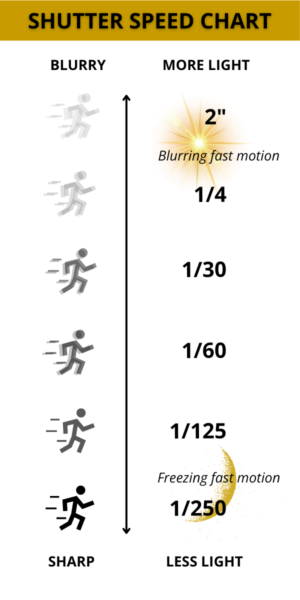
This speed chart will give you a good starting point to estimating the correct shutter speed you need for an image.
Understanding the effects of different shutter speeds will give you, the photographer, the control of what exactly you want to capture in the motion blur of a moving object and either less light or a lot of light in the image.
Settings
Now, let’s discuss the different settings on your camera that will allow you to control the shutter mechanism.
Camera Modes: Automatic
Automatic Mode
Let’s discuss my least favorite first, that being automatic mode.
My problem with auto mode is that the camera is “thinking” of the correct settings for what it thinks should produce the best exposure for you. BUT a camera has no brain. It can only guestimate settings based off of electronic programs created and installed into its software.

Automatic mode does exactly what you think it does.
It automatically adjusts your camera’s setting to produce what it believes will produce the most well-exposed image. This means your shutter speed will be modified to what the camera brain feels is the best shutter speed in relation to the other settings of the exposure triangle, being aperture and ISO.
In theory, this would be great. But 9/10 times, it’s not going to be the image that you’re aiming to achieve and can give you the best exposure editing after the fact.
Shutter Priority
Now, shutter speed priority is an interesting mode that gives you partial control of the ISO and aperture of your camera. Again, elements that make up the exposure triangle.
To set your camera to this setting, you have to know what symbol is used to represent it which is brand-dependent. For Canon, my brand of choice, it is represented by Tv which stands for Time Value. But on other cameras, like Nikon or Fujifilm, the shutter priority mode is represented simply by the letter S.

In shutter speed priority mode, you are able to fully control the shutter speed setting but the camera adjusts the aperture and ISO according to your manual shutter speed setting to give the best exposure of the image.
This allows you as the photographer to select the best shutter speed for whatever intent you have in mind quickly, without having to adjust the other settings, which can take time.
Manual Mode
Now, let’s discuss manual mode, which should be your top mode of choice, in my opinion. Full manual mode gives you full control over the motion blur of fast-moving objects in your image and exposure.
Some photographers think that this will be too time-consuming, but with practice you can get quite adept in knowing what shutter speed you need for the “look” you’re going for and what the other settings need to be for aperture and ISO to offset that.
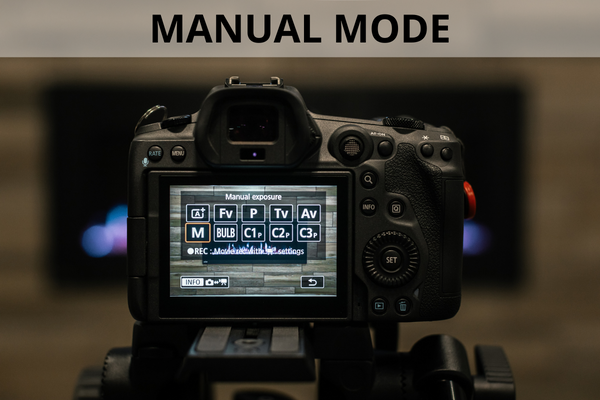
Just remember that 1) faster speeds like 1/500, 1/1200, 1/2000 are going to give you sharp images, in a sense, “freezing” the motion of an object whereas a slow shutter speed like 1/60, is going to capture the blur of that moving object.
And 2), you have to remember that adjusting your shutter speed dial is going to affect the light allowed into that image. Faster shutter speeds will darken the light allowed in, leading to a darker image, but a long shutter speed is going to allow more light in, leading to a brighter image.

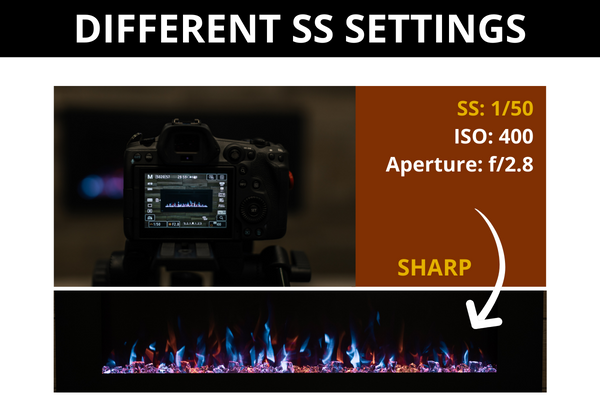

Knowing where these settings are on your camera and practicing adjusting them will give you a certain comfortableness with manual mode that I promise will lead you to love using manual over any other type of mode moving forward.
To get another perspective on shutter speed photography and how it works, you can check out this article by Photography Life. They provide great visual examples to understand this concept further.
Types of Photography Commonly Affected by Shutter Speed
Sports Photography
Let’s move on to some fun topics where certain types of photography are best served by adjusting your shutter speed.
Sports photographers have to know how to select the right shutter speed.
Sports are all about motion, and thus motion blur. Even golf because the golfer’s swing is moving at high rates of speed and create motion blur.
The best way to capture clear images of a sports player or object, in motion, is to have a high shutter speed. Depending on the speed of the object that is in motion, you’ll need to have a faster shutter speed to capture it or the person, without motion blur.
For example, using a shutter speed of 1/500 to capture a clear image of someone running in mid-stride.
Now I do not have a personal example to show you this in sports because I have yet to do any sports photography, but I can show you some images from a family photoshoot.
I had the brothers race each other to give them something fun to do but yet capture a family moment at the same time.
Here are my settings on my camera when I did so.
And for the record, I used a Canon R5 with 70-200mm EF lens, 16-35mm lens and Canon Mount Adapter.

Wildlife Photography
For wildlife photography, the same principle is going to apply. Quick shutter speeds are going to be the goal in order to capture clear images of animals without motion blur.
This will obviously change depending on the speed of the animal. Why not keep the shutter speed at a minimum shutter speed?
Because you might need to make adjustments to affect exposure, or aperture, or ISO.
Remember that photography settings require a balance between these three elements.
Adjustment of one, will affect the others.
Here’s a few examples of the shutter speeds used for wildlife photography captured in Grand Teton and Yellowstone national parks in Wyoming.


Landscape Photography
Ohhhh, now for the love of landscape photographers!
I love landscape photography but is not an easy type of photography. It is just so subjective. AND, especially on social media, the prettier the landscape is, the more intriguing it is to want to shoot images like that but realistically, most people do not live in areas where it’s easily accessible or known.
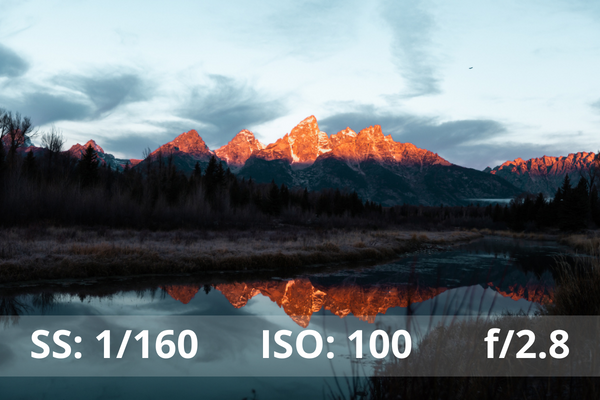
What I mean by that is most people are living in cities and suburbs. Finding areas where there are hills, valleys, mountains, ravines, waterfalls, etc. are not that easy to do in these type of living spaces.
Travel photography is a category that hugely incorporates landscape photography. A common theme and principle you’ll hear is “leave no trace” meaning, don’t pollute these areas, leave trash and whatnot. There are usually strict rules and guidelines for traversing national parks or areas known for their landscape, for this very reason. To preserve its beauty and keep it being “picture-worthy.”
I live in a small town right outside of San Antonio, Texas. I have not been able to practice landscape photography until I traveled to Wyoming for a vacation specifically focusing on the Grand Teton and Yellowstone national parks.
The reason why I feel like I haven’t been able to do so in my hometown is because areas with waterfalls or beautiful nature grounds are immediately surrounded by neighborhoods, shops, and other types of city or suburb-life.
That doesn’t mean to say that these places don’t exist, it’s just that it’s harder to capture.
I’ll be getting into travel photography in other upcoming blogs this year.
But for now what is important to note is that landscape photography has a special niche for utilizing long shutter speeds.
For example, if you’re trying to capture a waterfall and give it that artistic feel of flowing water and its movement, dropping your shutter speed for long exposures will give you the effect you’re looking for.
Remember, this increases the amount of time and light that comes in to your camera’s image sensor, but also increases the motion blur.
Here are some shutter speeds to increase the amount of motion blur of this waterfall in Wyoming.


Long Exposure Photography
Let’s briefly talk about astrophotography. This is photography that focuses on astrology, if that wasn’t obvious already.
It hasn’t been until recently that I’ve started to explore this type of photography. This falls into the category of long exposure photography.
What do I mean by “long exposure?” I mean increasingly slower shutter speeds to create long exposures.
This is necessary because at night, it’s obviously dark which means you have to have a way of bringing in light by either providing a light source or increasing the amount of time your image sensor is exposed to allow light in.
The best way to do so for atrophotography is to lower your settings for a longer shutter speed. That way you’re able to capture the light and details of the moon or stars without adding noise into your image by increasing ISO. “Noise” is artifact that comes from increasing ISO which is this artificial light our camera provides, which is layman’s terms for ISO.
However, the important thing to keep in mind is to use a tripod to reduce camera shake when performing long exposure photography.
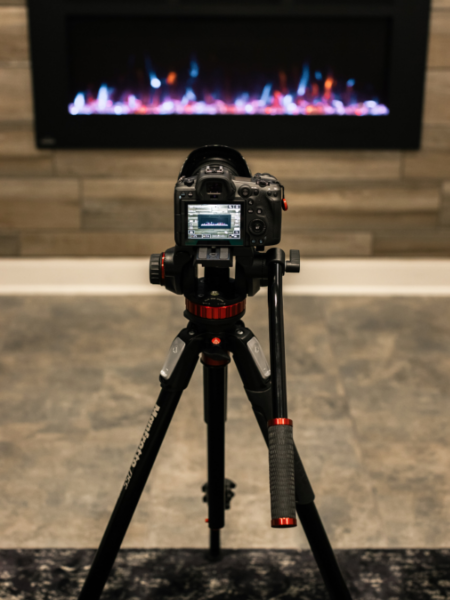
What do I mean by “camera shake?” Any type of movement can introduce motion blur at slow shutter speed settings.
Your camera is so sensitive at slow shutter speeds that even touching the camera to press the shutter button can shake the camera, introducing some motion blur. Even a little camera shake can produce a lot of motion blur at show shutter speeds.
To avoid this, use a tripod for your camera and set a timer or use an intervalometer or remote to trigger the image capture. This way, your camera is completely still when capturing the images.
Here are some examples of city nightlife photography to capture light streaks from moving vehicles as well as some moon photography.

Summary: Shutter Speed in Photography
To recap, shutter speed in photography is HUGELY important!
It is one third of the exposure triangle and is a part of a photographer’s settings that allow your creative side as a photographer to shine.

It controls the amount of light let in to the image sensor of your camera and affects motion blur. Long exposure settings that utilize slow shutter speeds as opposed to high shutter speeds can capture motion blur versus capturing clear images of objects in motion.
It all depends on what you need as a photographer in that moment.
Understanding this concept, how to modify it manually and why will set you apart as a photographer.
Furthermore, in order to understand all of these foundation core principles of photography, I highly recommend that you check out “What Is Aperture In Photography.” This will give you a breakdown of how aperture plays just as important a role in the exposure triangle and separate you from amateur photographers even as a beginner.
Remember to stay tuned for the last blog for the final concept of ISO in our exploration of the basics in photography education.
And lastly, go out, try this with waterfalls or any object or person in action and see how simple it is to learn!
I promise. Practice makes perfect.

